Ryan Hall's Blog, page 245
June 13, 2016
Cast of Friday Night Lights Reunites to Run a Spartan Race
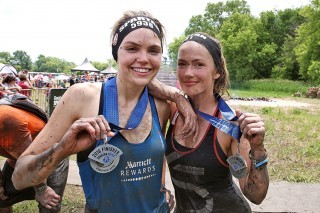
For the first time since the hit television show Friday Night Lights went off the air in 2011, four cast members from the show reunited in a unique way—by running the Chicago Spartan Super Race in Richmond, Ill.
Taylor Kitsch, Minka Kelly, Zach Gilford and Aimee Teegarden took on the 8.5-mile course with 29 obstacles as part of the global partnership between Spartan Race and Marriott Rewards. The cast members ran alongside two elite racers—Rose Wetzel and Ryan Kent, who competed earlier in the day.
Here are a few photos from their day, taken by Getty Images for Marriott:
Photo Gallery
1 of {count}
Back to Start
View Larger Image

Taylor Kitsch participates in the Spartan Super Race. (Photo by Tasos Katopodis/Getty Images for Marriott)
View Larger Image

Minka Kelly and Aimee Teegarden participate in the Spartan Super Race (Photo by Tasos Katopodis/Getty Images for Marriott)
View Larger Image

(Photo by Tasos Katopodis/Getty Images for Marriott)
View Larger Image

Zach Gilford and Aimee Teegarden participate in the Spartan Super Race (Photo by Tasos Katopodis/Getty Images for Marriott)
View Larger Image

(Photo by Tasos Katopodis/Getty Images for Marriott)
View Larger Image

Taylor Kitsch after completing the Spartan Super Race (Photo by Tasos Katopodis/Getty Images for Marriott)
View Larger Image

Zach Gilford after completing the Spartan Super Race. (Photo by Tasos Katopodis/Getty Images for Marriott)
View Larger Image

Aimee Teegarden and Minka Kelly after completing the Spartan Super Race (Photo by Tasos Katopodis/Getty Images for Marriott)
Related Galleries

13 Celebrities Running the 2014 NYC Marathon

Photos: 2014 Spartan Race World Championships

More Galleries
The post Cast of Friday Night Lights Reunites to Run a Spartan Race appeared first on Competitor.com.
June 12, 2016
Photos: 2016 New York Mini 10K
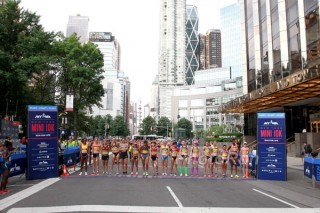
Kenya’s Jemima Sumgong won the 45th edition of the NYRR New York Mini 10K on Saturday, breaking the tape in 31:26 and leading a group of 17 Rio-bound Olympic marathoners and a record-number 8,833 finishers through the historic Central Park course.
Sumgong was tight with American Aliphine Tuliamuk for the first half of the course before breaking from the pack after the 5K mark to win in her event debut. Tuliamuk finished second in 32:14, and Burundi’s Diane Nukuri was third in 32:18.
Tuliamuk was born in Kenya and just became a U.S. citizen on April 29. She plans to compete in the 10,000 meters at the U.S. Olympic Trials. Americans Brianne Nelson (33:02) and Desiree Linden (33:17) finished fifth and sixth.
Here are photos from the race, taken by PhotoRun.net:
Photo Gallery
1 of {count}
Back to Start
View Larger Image

The race featured 17 women competing at the Rio Olympics later this summer.
View Larger Image

View Larger Image

View Larger Image

Desiree Linden finished sixth in 33:17.
View Larger Image

Allie Kieffer.
View Larger Image

Maegan Krifchin.
View Larger Image

Tuilamuk and Sumgong stayed close eary on.
View Larger Image

Lizzie Lee.
View Larger Image

Dot McMahan
View Larger Image

Brianne Nelson finished fifth in 33:02.
View Larger Image

Aliphine Tuilamuk recently became a U.S. citizen.
View Larger Image

Diane Nukuri would finish third in 32:18.
View Larger Image

Beverly Ramos of Puerto Rico finished seventh in 33:17.
View Larger Image

Kim Smith of New Zealand finished fourth in 32:41.
View Larger Image

Jemima Sumgong of Kenya won big, crossing in 31:26.
View Larger Image

Sumgong won by 46 seconds.
View Larger Image

The podium.
View Larger Image

It was one of Tuilamuk's first races since becoming a U.S. citizen.
View Larger Image

A kids race also took place on Saturday.
Related Galleries

Photos: 2015 New York Mini 10K

Photos: 2014 New York Mini 10K

2010 NYRR Mini 10K Photo Gallery

More Galleries
The post Photos: 2016 New York Mini 10K appeared first on Competitor.com.
June 10, 2016
Alisha Williams Puts Corporate Career on Hold for Run as a Pro
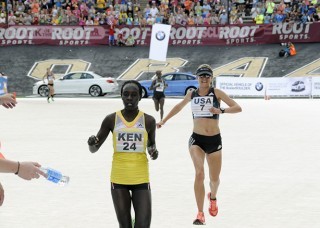
Alisha Williams, right, on her way to finishing eighth in the Bolder Boulder 10K on May 30. Photo: Brian Metzler
Alisha Williams might have never pursued her running career if it hadn’t been for Jim Carrey.
“I never intended to become a professional runner,” says the 34-year-old from Colorado Springs, Colo., who former senior financial reporting analyst of an oil company. “I always saw myself as a career woman.” However, in recognizing the short shelf-life of being a professional runner, she decided to put her career on hold—thanks also in part to a few inspiring words from Carrey.
Last spring, Williams was listening to the radio when Carrey’s graduation speech at Iowa’s Maharishi University of Management came on the air. Carrey spoke of his father, a CPA like Williams, who always took the safe route. “That’s totally me!” thought Williams. What struck her was Carrey speaking to risk taking in life where there is no guarantee: “You can fail at what you don’t want, so you might as well take a chance on doing what you love.”
“I got chills and thought, ‘Oh my gosh, Jim Carrey is talking to me!’” It was then that Williams decided to chase her dreams as a professional runner and put her lucrative corporate career on the back-burner.
So far, so good. Williams, who has a small sponsorship deal with adidas, was the first American runner to cross the line at the Bolder Boulder 10K on May 30, placing eighth in 34:42. She’ll be taking perhaps a few more risks than her CPA-self would like in order to pursue an U.S. Olympic Trials berth in the 5,000-meter run on June 12 at the Portland Track Festival at Lewis & Clark College in Portland, Ore.
Williams, however, has had to overcome several road blocks that would have sidetracked most athletes. In both April 2013 and April 2014 she faced metatarsal stress fractures that forced her to take six weeks completely off. After a couple years of intense training in Colorado Springs that broke her down, she decided to return to the man who had coached her at Western State Colorado University, two-time New Zealand Olympian Michael Aish—a man who believes health has to trump hard training.
While Aish has run in more than 10 world championships, he says he’s always trained harder than he could recover. As a result he’s learned to coach his athletes to not only get to the championships but to also perform well. Williams’ fitness was there when Aish began coaching her less than two years ago he says, but “she had no gas in the tank.”
Williams says she was fatigued and hungry all the time and was experiencing more and more discomfort with digestion. “I’d eat a big dinner and then a couple hours later I was starving again,” she said.
Initially she tried to heal her body by paying extra close attention to eating all the right food. She eliminated gluten for a year after her doctor, who wrongly diagnosed her with celiac disease, suggested gluten was a sensitivity that wasn’t showing up in tests. The elimination and careful attention to her diet didn’t help.
In the fall of 2015 a piece of the puzzle surfaced but went unnoticed. When she went on antibiotics to treat a tooth infection, she began to feel better and her running times improved. But then her symptoms returned and eventually worsened. She was experiencing chest pains (from acid reflux) and she was battling anemia.
Williams returned to the doctor this spring for more tests and this time was diagnosed with a bacterial infection called H. pylory—a naturally occurring bacteria in the gut that often causes ulcers. For years she had been living with a parasite that was preventing her body from absorbing the nutrients she needed. A massive deficiency in iron, for example, made it hard for her to get the oxygen she needed to train at altitude let alone fully benefit from the workouts.
Ten days before she ran the Bolder Boulder, she completed the prescribed two-week round of heavy duty antibiotics. Now on the mend, taking probiotics, iron pills and homemade sauerkraut, she has her sights set on the U.S. Olympic Trials in Eugene, Ore., where she’s already qualified to run the 10,000m on July 2. (She hopes to also get qualified for the 5,000m in Portland so she can run that event at the Trials beginning on July 7.) Considering she’s already run faster than the qualifying time (just a couple days outside the official USATF window), there’s a good chance she might be racing both at the trials.
“She’s always been a hidden talent with natural speed,” Aish says. He recalls her showing up her freshman year of cross country wearing baggy shorts and a cotton shirt. Williams, the youngest of four, began running at the age of 12.
“She is very calculated individual who doesn’t fly by the seat of her pants,” Aish says. “So, for her to quit her job was a huge commitment to running.”
She takes the time to do all the little things that give her the 1 percent edge, he says, like going to the pool post workout to ease recovery and being prepared post workout with a big lunchbox full of food.
“I told her if you can give it all and have no regrets, it doesn’t matter if you get last, you can walk away from the spot and say I gave it the best I had,” Aish says. “People who walk away with excuses can’t get better.”
Williams is leaving no room for excuses. “She’s one of the sweetest people I know,” says Aish, “but watch her with two laps to go in a race and you can see it on her face: She means business.”
It certainly sounds like Williams takes seriously to the business of pursuing what she loves.
The post Alisha Williams Puts Corporate Career on Hold for Run as a Pro appeared first on Competitor.com.
Chasing Adam: The Case of the Infidelity Tracker
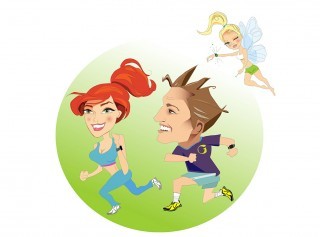
Illustration by Michelle Schrantz
This is the third edition of “Chasing Adam,” a new column from longtime running writer Adam W. Chase aimed at telling thought-provoking stories from all corners of the running world.
This is based on a true story. Some names and places were changed to protect the guilty. I don’t condone the actions contained herein, I’m only sharing the awkward and unexpected realities of the modern digital domain. Please don’t slay the messenger!
Felicity wasn’t a suspicious wife. Nor was she unsophisticated. On the contrary, she was rather tech savvy and it was that quality that turned out to be the bane of her now-ex-husband, Garth, a typical male who only thought he was electronically advanced but never read manuals.
It all began a few years ago with the gift of a GPS watch. At the time, Felicity was trying to lose some post-pregnancy weight and Garth figured a technology boost would help to motivate her to get back in shape. The couple had always trained together when they met during their heyday of triathlon, before the kids. Felicity used her Garmin for a while but soon found the older technology was more hindrance than benefit, given that she was short on time with the young children to raise, so she couldn’t afford the minutes it took to acquire a satellite lock before she could track pace and distance. Felicity enjoyed the data she got from the GPS so she bought herself a newer, higher-tech version and passed the old watch down to Garth, who began using it on a regular basis.
The problem arose when Garth’s “training” began to involve extracurricular activities. His straying went on for quite some time before Felicity had any clue. It was the technology that snared him because Garth continued to use Felicity’s old Garmin and, from time to time, when she checked her Garmin Connect account, she’d notice extra entries for workouts she hadn’t done. They were Garth’s training sessions instead. It didn’t mean much to Felicity so she ignored what she saw on the account until one day in October, when Garth was supposed to be on a business trip out of the country, Felicity noticed a run of just over 26 miles in Chicago on Garmin Connect.
“How could this be?” wondered Felicity. She was particularly flummoxed by the fact that the run took longer than 4:30. Felicity knew that Garth had been a steady 3:30 marathoner so she looked up the results of the Chicago Marathon and, not finding Garth’s name associated with the time, she cross checked the result with anyone from their hometown. Sure enough, Felicity found the time was associated with Wanda, a woman who belonged to their local triathlon club. Putting two and two together or, rather, one cheating running pacer schmuck together with a homewrecker who was much slower than Felicity, it all made sense. Or, rather, it all made infuriating nonsense.
When Garth returned home from his alleged business trip, even bringing gifts he must have purchased from Chi-Town’s Chinatown for Felicity and the children, Felicity knew her marriage had exceeded its lactate threshold. Being the romantic optimist, she hoped she could reconcile with Garth but those hopes were dashed when Felicity, who was familiar with Wanda’s suburban neighborhood, kept seeing that Garth’s running routes would include stops in that area. To make matters worse, Garth joined Strava and Felicity saw that he had defined a new segment that he named the “Wanda KOM.”
No surprise, but Felicity kicked Garth out of the house and filed for divorce. Garth continued to plead innocence and pretended he was faithful. That required Felicity to procure proof for purposes of the divorce and child custody dispute, a task made all the easier when Garth and Wanda bought his and hers Fitbits and synced them to the same Garmin Connect account to which Felicity still had access. Garth remained a dolt when it came to the workings of activity trackers or else he would have altered his activities or, at least, made them less obvious.
Although it was like watching a train wreck for Felicity, she nonetheless acquired gobs of documented salacious evidence of her miscreant soon-to-be-ex-husband’s shenanigans. Through the combination of Garmin Connect, Strava and Fitbit, she knew exactly when Garth and Wanda went to bed, what their heart rates were and Felicity even had a record of the comments they’d entered on their various training sessions. Prurient incriminations, such as Wanda’s log note, “First run after augmentation surgery. Chest felt tight and I still can’t lift my arms but it’ll be worth it!” Garth’s note back was, “Babe, you look so hot. Love your new boobs!”
RELATED: Chasing Adam—What Does Racing Mean to You?
Years ago, when they were showering after a masters swim, Felicity had witnessed Wanda’s Midwestern tramp stamp of the Dekalb corn cob logo. Apparently, that was a vision of the past because Felicity read Wanda’s comment from a jog, “Had to stop running today because the elastic on my shorts rubbed my lower back and it hurt too much from the laser removal.” Reading Garth’s innuendo-ed “corny” response made Felicity cringe with gratitude that she was no longer with the ass hat. She only hoped her children hadn’t inherited too many of his genes.
Fortunately, justice prevailed.
First, Felicity took Garth to the cleaners when the judge in the divorce proceedings ruled completely in Felicity’s favor after she presented the unequivocal electronic trail to rebut Garth’s tale of lies and deceit. But her sweeter victory came from knowing Garth’s training regimen so she stepped up her own program to one-up her ex. That, combined with the fuel of revenge, allowed Felicity to cream him at a local half marathon. It was meaningful because she knew he always targeted the annual race, all the more so based on this year’s Garmin Connect notes, and it was the race where they had first met a decade earlier. Back then, Garth finished on the podium, a full 15 minutes ahead of Felicity. This year, Felicity pipped Garth at the line, finished first in her age group and buried Wanda—and her implants—by a full 45 minutes.
What do I make of all of this? It’s simply a story about a cheating runner, a tale that sounds unusual yet could be about someone you know. It just goes to show that tracking your running data and pairing it with social media has evolved to such a state that people share much more than they might intend to publish on the Interwebs. Let’s just hope that Garth didn’t cheat by using a bike to set a running KOM.
****
About The Author:
It’s actually easy to chase Adam W. Chase because, as a guy who just hit 50 and has run more than 150 marathons and ultra-distance races, he’s self-admittedly rather slow. Adam writes a little faster and also serves as President of the American Trail Running Association and works as a lawyer in Boulder, Colo. Adam was inducted into the Colorado Running Hall of Fame on April 20.
The post Chasing Adam: The Case of the Infidelity Tracker appeared first on Competitor.com.
June 9, 2016
7 Things to Know About GPS Watches
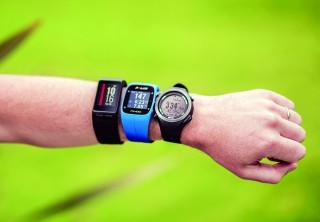
Photo: Oliver Baker
Much has changed in the GPS running watch world in the past couple years. Run-focused watches have dramatically upped their game, largely driven by the appearance of the Apple Watch, a non-GPS watch requiring an iPhone for GPS. Although your older watch can still track the basics of GPS distance and pace just fine, here is what you can expect from an upgrade.
1. Heart rate on the wrist
No one really likes those chest straps, despite the valuable guidance they provide training and racing. Many GPS watches now offer wrist-based heart rate monitoring through optical light sensors on the back of the watch. Increasingly, they also provide 24/7 heart rate monitoring, a key to determining your overall status and stress. They rapidly approach, and in some conditions surpass, chest straps in run reliability and accuracy. But they have yet to provide all the data of the chest approach such as heart rate variability.
2. Sleep, activity and physiology
Many modern GPS watches track not only your workout, but through accelerometers can also track your sleep quality. And they can track your total daily activity—those “steps and stairs.” When used with heart rate monitoring, many can analyze the intensity of your workout and advise on recovery time until the next hard effort. Although none we know of so far takes the entirety of a day’s heart and activity data to fine-tune recovery time.
3. More sensors
GPS watches are essentially a collection of sensors. It starts with a GPS sensor, which, when connected to the app, updates the location of satellites for faster acquisition and greater accuracy at workout go time. Higher-end multisport watches can include altimeter, barometer, compass and even a thermometer. For mountain runners, data such as percent grade, vertical speed, altitude and ascent decent can be displayed live. The same accelerometers that capture activity and sleep also capture cadence. Many watches can also read, display and store data from external sensors such as heart rate chest straps and wrist bands, bike sensors and even run power sensors. Be aware that external sensors can operate on one or both of two
frequencies, ANT+ and Bluetooth, and that your watch must be able to hear the frequency of the sensor used. Garmin only hears ANT+ sensors.
4. Music
Some of us train with music but would prefer to leave the phone behind. There are GPS watches available with 500-song music players and use Bluetooth wireless earpieces. Most new watches also allow basic control of music playing on a nearby phone.
5. Phone notifications and control
Many watches can optionally display phone app notifications, texts and incoming phone call numbers. Some even let you answer the phone to an earpiece.
6. Enhanced apps, web sites and
third-party connections
The apps and websites receiving all your data continue to improve in functionality and reliability. No longer is it necessary to “plug” the watch into a computer to upload workout data. It now streams via Bluetooth to the watch’s phone app and website, where you can review your workouts in far greater detail than just overall time, pace and distance. Then, if you choose, your data can flow automatically to third-party training and social sites.
7. Shapes, sizes, colors and battery life
Don’t like the serious gray look all the time? GPS watches now come in different colors, shapes, interchangeable bands and fashionable bezels. Screens are crisper with overall size, thickness and weight shrinking. As all those sensors get smaller and more efficient, and as communications protocols and software continue to be tuned, battery life, even with wrist heart rate, will likely be better than your old clunker.
RELATED: 9 Tips and Tricks for Your GPS and Heart Rate Monitor
The post 7 Things to Know About GPS Watches appeared first on Competitor.com.
Coach Culpepper: Add Variety to Your Training
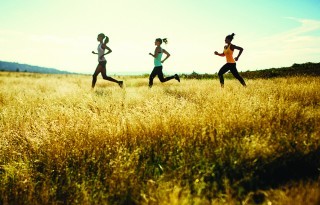
Photo: Istockphoto.com
For some athletes, it can be alluring to run the same three routes day after day—perhaps with some variation for the weekend long run. Training over different types of terrain, however, can spur physical gains and provide mental relief. Consider the following as you train for your next event.
Trail running for road racers
A lot of runners who primarily race on the roads have an aversion to trails. And with good reason: They can be intimidating! As a competitive athlete, I did not like the idea of running slower but having an elevated heart rate on what was supposed to be a recovery run. There was also the fear of twisting an ankle or looking down at my watch in shock of how slow I was actually running. Eventually, though, I learned that trail running benefited my road racing, largely due to the added leg strength and aerobic gains from training on hilly terrain. Trails, in essence, force you to use more muscles—even though you’re running slower. You will also develop lower-leg strength from running on uneven footing as your feet, ankles, Achilles tendon and calves all adapt to new stimuli. When incorporated into a comprehensive training program, all of these factors benefit road racing.
RELATED: How to Find a Good Running Trail
Road running for trail racers
Conversely, many trail racers fear stepping on pavement of any kind since they never intend to race on the roads and/or fear getting injured. While that is a valid concern, it’s important to remember that you can only run so fast on uneven or undulating terrain. By strategically including some road running in your training routine, trail racers can become more efficient at quicker paces, hit targeted pace or distance goals and develop better running mechanics—all of which will benefit their off-road racing.
Track workouts for everyone
Adding track workouts into your routine is another way to include variety in your training program. Any runner, regardless of what type of event they’re training for, can benefit from running some speed workouts on the track. The key is dialing in the right effort level. The biggest mistake most athletes make is running too fast for intervals that are too short, which often leads to injury. Ease into the track workouts with controlled longer intervals over 800 meters, or even a tempo run. The controlled nature of the track leads to more productive workouts. Keeping a close eye on pacing also teaches you how to gauge your effort levels based on how you feel.
RELATED: 7 Tips for Track Workouts
The post Coach Culpepper: Add Variety to Your Training appeared first on Competitor.com.
How to Find a Good Running Trail

Photo: Istockphoto.com
If you love trail running and are traveling or just moved to a new place—or you just want to try it for the first time—how do you know where to go? Here are a few tips:
1. Keep your eyes peeled
This approach can find numerous trails—some long, some short, some that lead to greater networks that go on for miles—while just out running roads and exploring. True, there’s the chance that small ribbon of dirt might end 50 feet later, but it might just wind through a neighborhood and pop out next to a babbling creek. And there’s something very rewarding about simply discovering a trail by exploring.
2. Team up
Local trail runners obviously know the trails in the area. They’ll know the steep ones, the flat ones, the rocky and the rutted, as well as what trails are ideal in different weather and different times of year. To find local trail runners, ask around. You might be surprised to find your neighbor, your son’s teacher or your friend’s friend is a trail runner.
3. Join a group run
Trail running clubs, and even road running clubs, usually have weekly group runs on trails. Most are friendly, casual, and made for all speeds and levels of runners, where no one will be left behind or lost. (Some clubs have speed-oriented runs, in which case the group run will be labeled as such.) Running specialty stores also host runs, often on trails, and many areas have trail running “meet-ups.” Search online for “group trail run” and the name of the town or region and you should find some options.
4. Ask around
Aside from specialty running stores, outdoor stores that carry hiking, camping and general outdoor equipment are not only great places to shop, but the salespeople are generally helpful and knowledgeable. (There’s a reason people work at outdoor stores; it’s because they love doing sports outdoors.)
5. Search online
It may be obvious to do a web search for nearby trail runs. But consider also searching for hiking and mountain biking trails in the area. Sometimes there’s more information on hiking and mountain biking trails than for trail running, and those trails may very well be prime for running.
Tip: Be sure to consider what types of trails you’re looking for—from smooth and flat to steep and gnarly—when asking around or searching online. Being specific will help you find the perfect off-road route for whatever your mood or experience level.
RELATED: 6 Summer Trail Getaways
The post How to Find a Good Running Trail appeared first on Competitor.com.
What Runners Should Know About Micronutrients
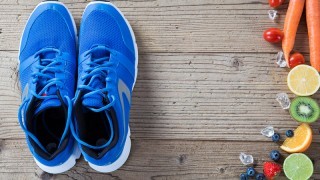
You are what you eat, and when you’re an athlete, your choice of fuel and how you eat on a regular basis can be the difference between a PR and a plateau or injury. Clean eating does more for your body than just help you maintain a healthy weight. When your diet includes the proper foods to meet the nutritional needs your body demands, your health and performances benefit—and micronutrients are a big part of that.
Macronutrients vs. Micronutrients
Macronutrients are the meat and potatoes—literally—of the diet. Carbs, fats and proteins typically make up the bulk of runners’ meals, and while important to energy production, recovery and injury prevention, they often overshadow the just-as-important micronutrients, or vitamins and minerals. These vital nutrients are found in whole foods like fruits, vegetables, legumes and whole grains. They are the “magic wands” that allow the body to properly produce enzymes, hormones and other important substances that aid growth and development, according to the World Health Organization. Not to mention they play a crucial role in repairing muscle tissue when recovering from exercise or injury.
As evident by their names, we need macronutrients in much larger amounts and micronutrients in smaller quantities. However small, the importance of micronutrients shouldn’t be overlooked, according to Eve Pearson, a registered dietician, certified specialist in sports dietetics and adjunct professor at Southern Methodist University, as different micronutrients serve varying, crucial roles in our bodies.
“The B vitamins are known for helping us access the energy we eat from carbohydrate, protein or fat,” Pearson says. “The electrolytes aid in fluid balance. There are specific micronutrients, such as magnesium, calcium and vitamin D, that aid in bone health.”
Eating the proper amount of micronutrients is crucial as they are not naturally produced in the body and must be obtained from diet, according to the Centers for Disease Control and Prevention.
Pearson said a lack of vegetables is the most common nutritional deficit she’s seen in her experience working with various athletes. And it can lead to big problems.
“When an athlete isn’t consuming enough (micronutrients), it’s possible normal body processes aren’t occurring at the most efficient level,” Pearson says. “This can ultimately result in injuries, cramping, stress fractures among other things.”
Low consumption of vegetables, as well as fruits, appears to be a national problem. Less than 1 in 10 Americans eat the recommended servings of fruits and vegetables a day, according to a 2015 CDC report. The government recently responded by raising the daily recommendation for the average person from 3-5 servings of fruits and vegetables a day to 5-9. That’s still low for athletes, however. In order to adequately keep athletes healthy, some experts recommend 13 or more servings! Sounds crazy, but let’s look at why.
What are Free Radicals?
We are exposed to a number of subliminal environmental stressors every day—from pollution and radiation, to mental and physical stress (including exercise)—that directly affect our health. Said stressors create free radicals in our bodies. Simply put, free radicals are molecules that lack an electron, and roam freely in our bodies searching for another electron. They can attack and damage our healthy cells in the process.
Escaping free radical production completely is unavoidable (we drive cars and use cellphones, for example), but nevertheless this exposure increases the number of free radicals we have, according to a National Center for Biotechnology Information (NCBI) study. Exercise is a huge creator of the molecules, which puts athletes at a greater risk of what’s called oxidative stress.
What is Oxidative Stress?
We all breathe in oxygen, and we, of course, need more of it when running. But oxygen, being a volatile molecule, has a propensity to create free radicals. If our bodies do not have the proper defenses to fight off these pesky radicals, the imbalance—known as oxidative stress—can be damaging. Our living cells can be harmed.
Oxidative stress is a natural process that everyone experiences and is healthy at low levels, but it occurs at much higher rates in athletic people, especially high-endurance athletes, according to a NCBI study; think the more oxygen needed to exercise, the more prone to oxidative stress. Therefore, high endurance athletes like runners are at a greater risk of experiencing the numerous effects of oxidative stress, from accelerated aging to damaged immune cells. Performance-prohibiting effects for athletes also include burnout, chronic fatigue, muscle soreness, inflammation, and muscle damage.
How could all of this come from what you put—or don’t—on your plate every day? The thing is, most of these effects don’t show up until later, when you experience them full on. You can’t immediately feel if a cell is being damaged or you’re not absorbing enough vitamins and minerals, for example. Good nutrition, just like being a good runner, is a lifestyle. Depriving your body of the essential nutrients it needs to stay active and healthy adds up over time. It’s important to be aware of the potentially negative effects that training and racing can have on our bodies and long-term health. The key is to balance it with proper nutrition. So how do you know that you’re protecting yourself and your performance?
The Antidote
Eat whole foods—and plenty of them. The vitamins and minerals, namely antioxidants, found in whole foods help decrease oxidative stress. Antioxidants help neutralize free radical production, which restores a balance and decreases the chance of cell damage. Remember, runners are at a greater risk of oxidative stress, and the negative effects that come with it. So eating more fruits and veggies can help keep free radicals at bay.
While 13 or more servings a day may sound intimidating and unrealistic, Pearson says to keep it simple: try to incorporate fruits and veggies at every meal and snack. There are a number of easy, and sneaky, ways to do so.
“Remember that for fruits and raw vegetables, a serving is only 1/2 cup. It’s easy to get more than one serving at each meal or snack! Vegetables can be incorporated into quiches or smoothies at breakfast…I also like to pick up a veggie tray each week at the grocery store because when life gets busy it’s easy to pull that out to snack on,” Pearson said.
Make adding more micronutrients into your diet a challenge. What creative ways can you include more fruits and vegetables to your snacks and meals? Your future healthy self and your athletic achievements will thank you.
The post What Runners Should Know About Micronutrients appeared first on Competitor.com.
Study Looks at Max-Cushioned Shoes and Running Economy
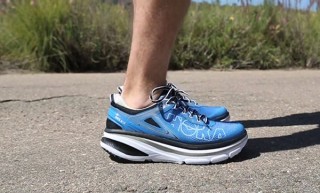
The Hoka One One Bondi 4, used in the study.
Researchers at the University of Nevada-Las Vegas took a closer look at the max-cushioned running shoe craze. Specifically, they wondered what larger, more cushioned running shoes can do to a runner’s economy.
The researchers—Miles A. Mercer, Tori Stone, Jack Young and John Mercer of UNLV—presented their findings last week at the American College of Sports Medicine meeting in Boston. In their small study, 10 experienced runners were fitted with a pair of neutral running shoes with traditional cushioning (a pair of Adidas with Adiprene cushioning) and a pair of max-cushioned running shoes (Hoka One One Bondi 4s). Over two days, the runners did several sessions on the treadmill at various speeds and inclines. Each session lasted about 10 minutes and VO2 Max—an indication of running economy—was measured.
RELATED: Super Cushy Rides: 15 Max-Cushioned Running Shoes
The conclusion? Researchers found that VO2 Max was not influenced by the shoe the runners were wearing. VO2 Max, as expected, was impacted by the speed of the treadmill and the incline of the treadmill—but not by which shoe the runners were wearing.
“It seems that the cushioning of the shoe (extreme vs. regular) play no role in the influence of running economy,” the study concludes.
Mercer told the New York Times that his colleagues hope to study injury patterns of max-cushioned shoes in the future.
The post Study Looks at Max-Cushioned Shoes and Running Economy appeared first on Competitor.com.
Molly Huddle to Run the 2016 New York City Marathon
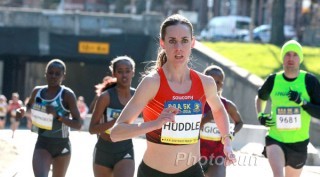
Photo: PhotoRun.net
Molly Huddle will make her long-awaited marathon debut at the New York City Marathon on Nov. 6, race organizers announced on Thursday.
The 31-year-old has been wildly successful at shorter distances, establishing herself as arguably America’s top distance runner over the past few years. She’s the reigning U.S. champion in the 10,000m on the track, a 2012 Olympian at 5,000m and last year was the U.S. champion on the roads at 5K, 10K, 12K, 10-mile and 20K. She’s also run a half marathon in 1:07:41, an American record for an all-women’s race.
She’s currently preparing for the U.S. Olympic Trials on the track, with hopes of making her second Olympic team this summer. But after that, she will start her first marathon build-up.
“It’s with excitement that I am going to run my first marathon this fall, and I am honored and delighted to do so at the TCS New York City Marathon,” Huddle said in a press release. “As a native New Yorker and someone who has watched my training partners race through the city many times in the past, I felt like New York has been calling to me for many seasons.”
Several top American women have gone a similar route in making their marathon debut in New York. Kara Goucher debuted in New York in 2008, running a 2:25:53 to finish third overall. In 2011, Shalane Flanagan made her marathon debut and ran a 2:28:40 to finish second.
What Huddle can accomplish over 26.2 miles has been a source of intrigue in the running world for several years now.
“It feels like running a marathon is a rite of passage as a distance runner, and with my strength work going better than ever, I finally feel ready to tackle that distance on a course and in a city whose grit and vibrancy inspire me,” Huddle said. “I always love running NYRR races from one mile up to 13.1, and by now the city feels like a home course.”
NYRR also announced the introduction of the U.S. prize purse for the New York City Marathon. In 2016, it will total $116,000, with the top male and female American each taking home $25,000. To be eligible, athletes must have U.S. citizenship and not be eligible to represent another country in international competition.
The post Molly Huddle to Run the 2016 New York City Marathon appeared first on Competitor.com.
Ryan Hall's Blog
- Ryan Hall's profile
- 21 followers



